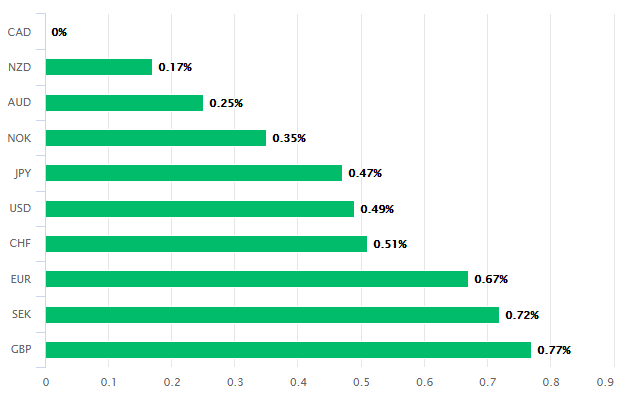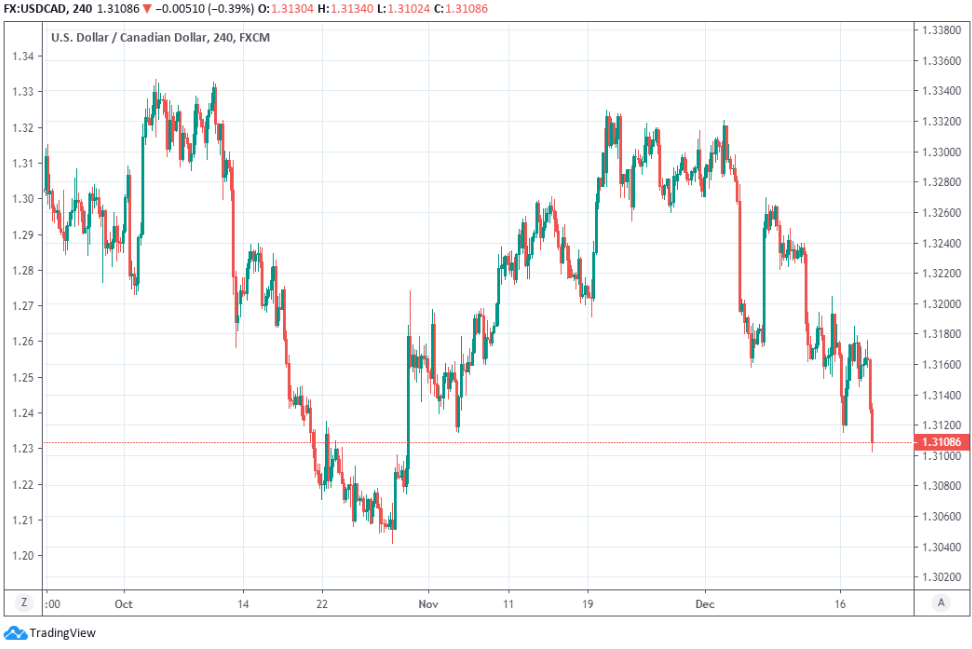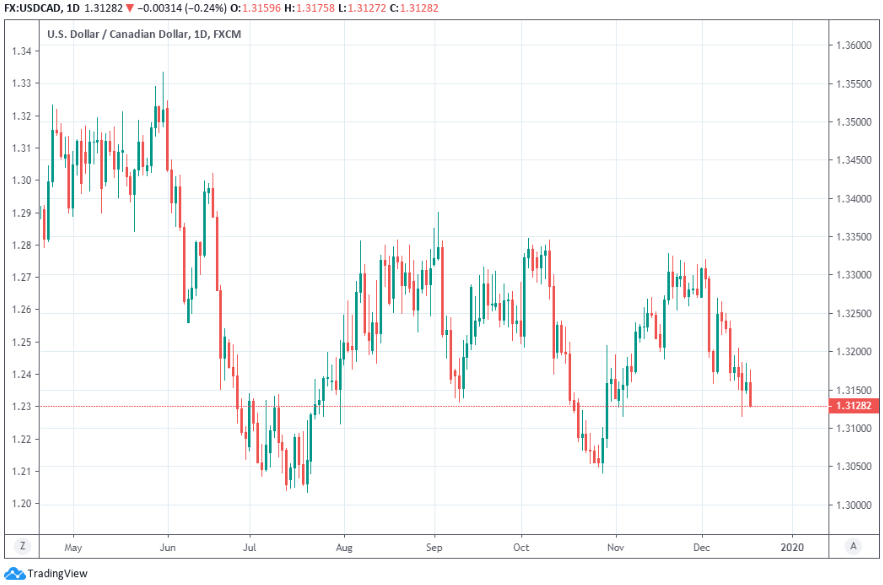The Canadian Dollar Celebrates Inflation Gains but Some Are Looking to Cash Out and Walk Away
- Written by: James Skinner

Image © Bank of Canada, Reproduced Under CC Licensing
- CAD advances on USD and GBP after inflation beat.
- BoC's core measures of inflation ticked higher in Nov.
- But gains limited by BoC that's firmly on hold for now.
- USD now main driver of CAD, CIBC research shows.
- CIBC looks to cash out of bet on CAD around 1.3050.
The Canadian Dollar got the better of all its major rivals Wednesday after being aided by a surprise increase in the Bank of Canada's (BoC) preferred measures of inflation but some once-bullish local analysts have said they intend to exit bets on the Loonie ahead of anticipated weakness in 2020.
Statistics Canada said Wednesday that inflation fell 0.1% in November, although the annualised rate of price growth remained steady at 2.2%. However, two of the BoC's three preferred measures of inflation, which are variants of 'core inflation', rose last month and one of them by much more than was expected.
The BoC's 'trimmed CPI' measure rose from 2.1% to 2.2% in line with expectations last month while the 'median CPI' jumped from 2.2% to 12.4% when markets were looking for an unchanged reading. This saw the average of the three core measures creep higher from just under 2.1% to just under 2.2%.
All those numbers are above the 2% target of the BoC and come hard on the heels of a quarter that saw the economy slow noticeably, which may have led some to conclude that the BoC will have little scope to justify following the lead of some counterparts by cutting Canadian interest rates in the near future.
"The jump in headline inflation in November was mostly due to base effects, with energy prices having fallen sharply toward the end of 2018," says Josh Nye, a senior economist at RBC Capital Markets. "We don't think today's inflation data ties the Bank of Canada's hands. Policymakers will likely be more influenced by next week's October GDP report, which we think will set up for another quarter of sub-trend growth in Q4. That should leave the door open to a rate cut."

Above: Canadian Dollar performance Vs major rivals on Wednesday. Source: Pound Sterling Live.
Markets care about inflation data because it's exactly these price pressures the BoC is attempting to manipulate with its interest rate policy, with hikes to the cash rate being deployed to ensure the consumer price index does not deviate meaningfully above the target while cuts to the benchmark for borrowing costs are used to ensure the price index doesn't fall too far below the target in subsequent years. Inflation is sensitive to growth and many other things.
The Bank of Canada sounded an almost hawkish tone earlier this month when it said it sees "nascent evidence" of a stabilisation in the global economy, weakness of which has been a key driver of the bank's caution earlier this year. It also noted stronger-than-expected business investment during the recent quarter before telling markets that inflation is still likely to average 2% over the next two years even if some months do yield above-target increases.
BoC policymakers will be watching consumer spending, housing activity and business investment closely over the coming months for signs that those sources of economic resilience are coming under pressures from the global economic slowdown brought on the by the U.S. trade war with China. Markets had expected the BoC to follow the Fed and others by cutting rates soon rather than continuing to stand apart from the crowd but the December policy update suggests the BoC is firmly in an 'on hold' stance.
"Given we have less than a 33% chance of a cut priced in by year-end 2020, we see asymmetry in buying the front-end via Bax March 21 contracts or 2s," says Andrew Kelvin, a bond market strategist at TD Securities.

Above: USD/CAD rate shown at 4-hour intervals.
Deputy BoC Governor Timothy Lane told the Ottawa Board of Trade this month the BoC's apparent 2019 divergence from the Fec has been overegged by the market and that Canada can tread its own path as far as monetary policy is concerned. That and the December statement have seen investors grow more confident that the BoC will remain on hold for at least the foreseaable future, which has lent support to the Canadian Dollar.
Canada's Dollar was again the best performing major currency of 2019 Wednesday following steep losses for Sterling, which held the top spot for only a matter of weeks when fresh Brexit-related woes led the currency to hand all its post-election gains back to the U.S. Dollar, Euro and other rivals on Tuesday.
BoC rate policy and Canadian economic outperformance have been key to the Loonie's 2019 ascent but CIBC Capital Markets says the U.S. Dollar is now the most important driver of the outlook for the smaller Dollar.
"USD/CAD price action is not being driven by relative central bank expectations, or the price of oil right now. Instead, it’s broad USD moves that matter," says Bipan Rai, CIBC's North American head of FX strategy. "Price action is trapped within the 1.30-1.3350 range. We are playing this range for now and are tactically short USD/CAD looking to take profit at the 1.3050 mark....We still expect USD/CAD to resolve higher over the long-term."

Above: USD/CAD rate shown at daily intervals.
Canada's Dollar has traditionally had a number of different drivers, with oil prices, relative U.S.-CA interest rate expectations and the direction of the S&P 500 stock index normally vying with each other to be the dominant driver of flows. However, modelling work done by Rai and the CIBC team has found moves in the broad value of the U.S. Dollar have slowly but surely become the most significant influence on Canadian Dollar direction in recent months.
The bank has been betting on a decline in the USD/CAD rate for weeks but is now looking to exit that bet around 1.3050, after having lowered its 'stop-loss' to just above the 1.32 level in order to lock-in some profits from the trade. However, CIBC is tipping a Canadian Dollar depreciation for 2020 and among the numerous reasons for that view is the expectation that the BoC will after all cut Canadian borrowing costs early next year.
Investors and the Canadian Dollar, are unprepared for a BoC cut so such a thing could make waves in the market if one is announced. Pricing in the overnight-index-swap market implies the BoC's cash rate will sit at 1.69% after the June 03, 2020 meeting which is below the current 1.75% level but substantially above the 1.50% that would prevail in the wake of a typical 25 basis point cut.
"Given that we are bearish the USD as part of our reflation theme, the above result is a risk to our view that the CAD will underperform the USD. Still, we do envisage that weaker incoming data will move the market to price in rate cuts from the BoC next year. That implies that front-end spreads should return as the dominant driver for USD/CAD," Rai says in a note to clients.
Time to move your money? The Global Reach Best Exchange Rate Guarantee offers you competitive rates and maximises your currency transfer. Global Reach can offer great rates, tailored transfers, and market insight to help you choose the best times for you to trade. Speaking to a currency specialist helps you to capitalise on positive market shifts and make the most of your money. Find out more here.
* Advertisement





